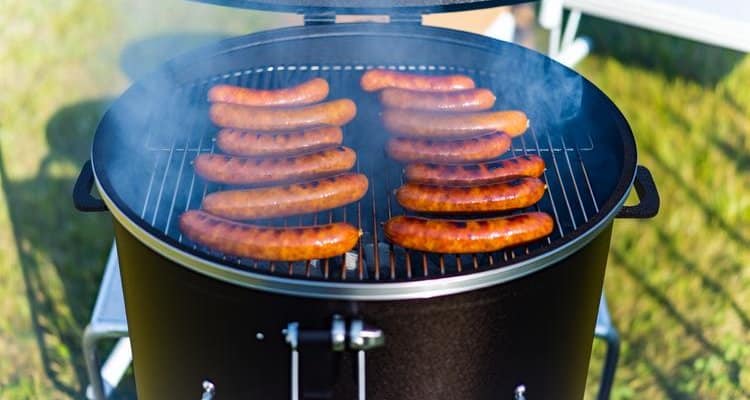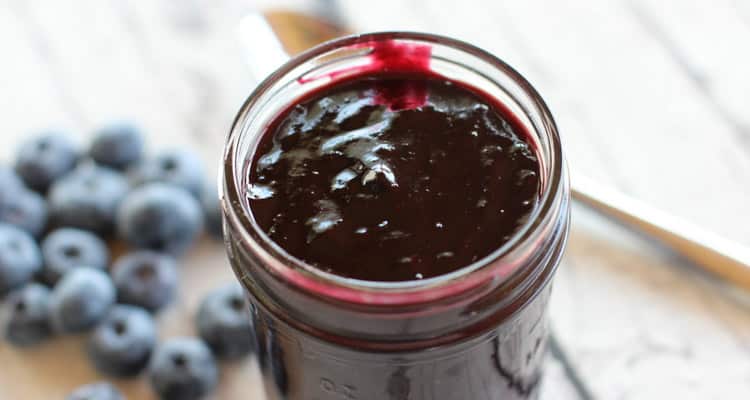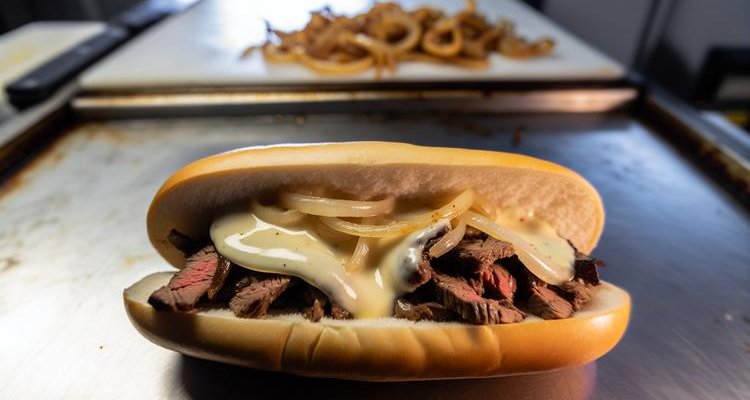
The sizzle of paper-thin ribeye hitting a scorching flat-top griddle, the sweet aroma of caramelized onions filling the air, and the satisfying sight of melted cheese cascading over tender beef—these are the hallmarks of an authentic Philly cheesesteak. While Philadelphia street vendors have perfected this iconic sandwich over decades, you can achieve restaurant-quality results at home with the right flat-top griddle technique. This comprehensive guide walks you through every critical step, from selecting the perfect cut of ribeye to mastering the ideal griddle temperature that transforms simple ingredients into one of America’s most beloved sandwiches.
The Flat-Top Advantage: Why This Method Matters
Philadelphia cheesesteak shops didn’t choose flat-top griddles by accident. The expansive, evenly heated surface provides unmatched temperature control and cooking space that’s impossible to replicate in a standard skillet. When you’re working with ultra-thin sliced ribeye, maintaining consistent 400-425°F heat across the entire cooking surface prevents some pieces from overcooking while others remain underdone. The flat-top’s thermal mass also recovers quickly when you add cold ingredients, ensuring that searing action never stops.
Beyond temperature control, the generous workspace allows you to caramelize onions in one zone while simultaneously cooking meat in another—exactly how the pros do it in Philadelphia. If you’re serious about outdoor cooking and want to expand your griddle repertoire beyond breakfast favorites, investing in one of the best flat-top grills will elevate everything from smash burgers to hibachi-style dinners. The techniques you’ll learn here translate directly to countless other flat-top applications.
Choosing Your Ribeye: The Foundation of Flavor
Ribeye is non-negotiable for authentic Philly cheesesteaks. This well-marbled cut delivers the rich, beefy flavor and tender texture that defines the sandwich. Look for ribeye with visible marbling throughout—those white fat streaks melt during cooking, basting the meat from within and creating unmatched juiciness. Understanding choosing quality ribeye helps you identify the best candidates at the butcher counter.
The thickness—or rather, thinness—of your slices is equally critical. Professional cheesesteak shops use commercial slicers to achieve paper-thin cuts that cook in seconds. At home, the butcher’s trick is simple: freeze your ribeye for 30-60 minutes until firm but not rock-solid, then use your sharpest knife to cut slices as thin as possible. You’re aiming for translucent pieces that you can almost see through. Many butchers will slice ribeye to your specifications if you ask—request “shaved” or “cheesesteak cut” at about 1/16-inch thickness.
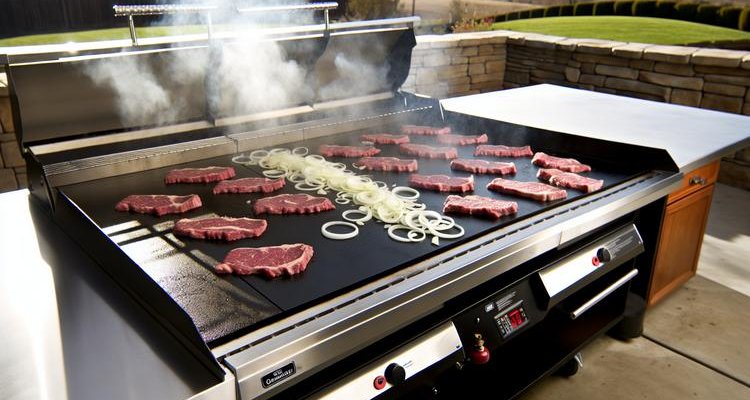
Mastering Griddle Temperature and Timing
Temperature precision separates mediocre cheesesteaks from exceptional ones. Preheat your flat-top griddle to 400-425°F—hot enough to achieve rapid searing without burning. If you don’t have a temperature gun, use the water droplet test: a few drops should dance and evaporate within 2-3 seconds. Too hot, and your meat chars before cooking through. Too cool, and you’ll steam rather than sear, resulting in gray, flavorless beef.
Start with the onions, as they require 8-10 minutes of cooking time to achieve proper caramelization. Slice them into thin half-moons and spread them across a cooler zone of the griddle (around 350°F). Season with salt and stir occasionally, allowing natural sugars to caramelize into sweet, golden strands. The techniques used in perfect griddle steak technique apply here—maintaining distinct temperature zones lets you control each element independently.
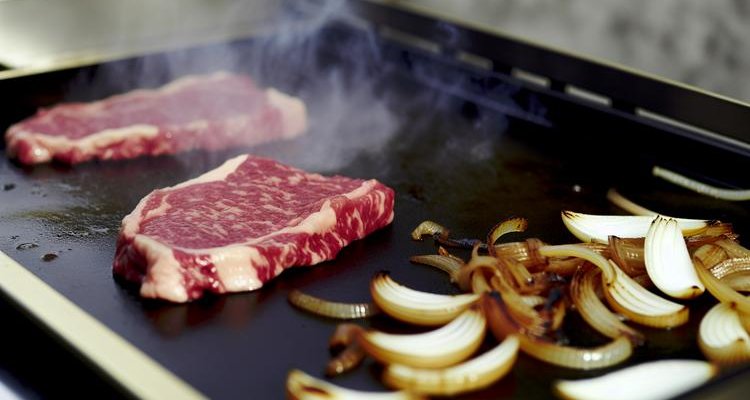
When your onions are golden and your ribeye is prepped, crank the heat to the 400-425°F zone. Add a small amount of neutral oil (avoid butter, which burns at these temperatures), then spread your sliced ribeye in a thin, even layer. Resist the urge to move it immediately—let the meat develop a sear for 30-45 seconds. Then, using two metal spatulas, chop and toss the meat with quick, decisive motions. This chopping technique breaks up any remaining larger pieces and ensures even cooking. The entire meat cooking process takes just 2-3 minutes.
The Great Cheese Debate: Whiz, Provolone, or American?
Ask ten Philadelphians about proper cheesesteak cheese, and you’ll get ten passionate opinions. The truth is, all three options are authentic—it depends which shop you visit. Cheez Whiz delivers that signature creamy, pourable consistency and sharp, salty flavor that many consider the gold standard. It melts instantly on contact with hot meat, creating seamless integration between cheese and beef.
Provolone offers a more sophisticated flavor profile with subtle tang and excellent meltability. White American cheese splits the difference—mild, creamy, and melts beautifully without Whiz’s processed texture. For the best results on a flat-top, place your cheese choice directly onto the hot meat pile during the final 30 seconds of cooking, then immediately cover with a metal bowl or dome to trap steam. This melting method creates that glossy, fully integrated cheese coating that defines a proper cheesesteak.
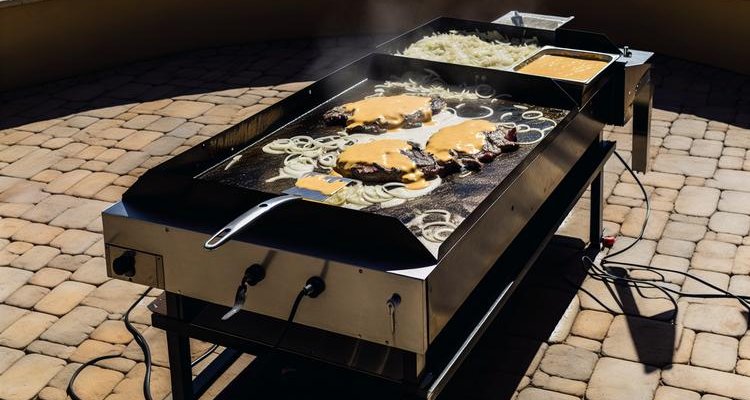
Assembly Technique: Building the Perfect Sandwich
The assembly process matters as much as the cooking. Toast your hoagie rolls cut-side down on a cooler zone of the griddle for 60-90 seconds until lightly golden. This crucial step creates a moisture barrier that prevents the bread from becoming soggy. Fresh Italian hoagie rolls with a tender interior and slightly crisp crust are ideal—avoid overly crusty bread that’s difficult to bite through.
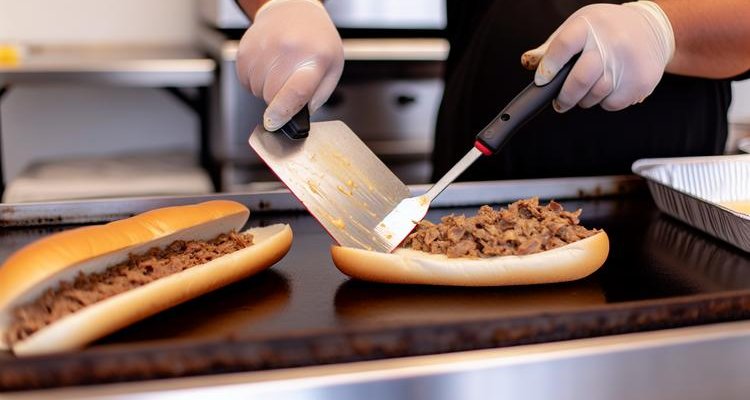
When your cheese has melted and your rolls are toasted, use your spatulas to scoop the entire meat-cheese-onion mixture in one motion and deposit it into the roll. Work quickly to maintain heat. The classic Philly presentation keeps toppings minimal—hot or sweet peppers are acceptable, but ketchup, mayo, and lettuce are considered sacrilege by purists. If you want condiments, a thin line of mayonnaise or hot sauce is your limit.
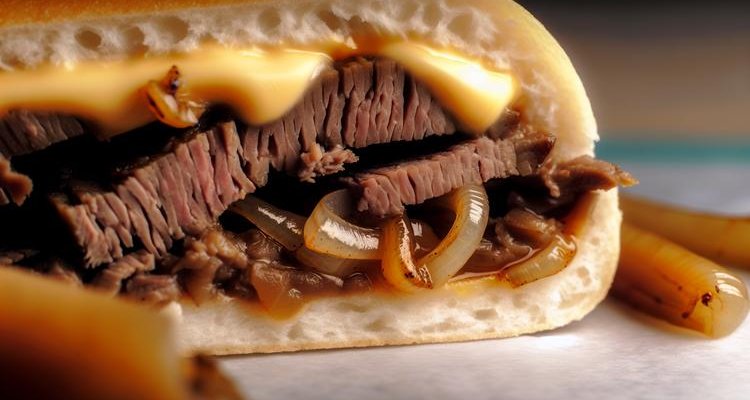
Common Mistakes and How to Avoid Them
Using the wrong cut of beef: Sirloin, chuck, or pre-sliced “sandwich steak” lack ribeye’s marbling and tenderness. Don’t substitute.
Overcrowding the griddle: Too much meat at once drops the surface temperature, causing steaming instead of searing. Cook in batches if making multiple sandwiches.
Moving the meat too soon: Let the initial sear develop for 30-45 seconds before chopping. Premature stirring prevents proper browning.
Skipping the steam dome: Cheese needs trapped heat to melt evenly. A metal bowl, pot lid, or commercial dome is essential.
Cutting corners on bread quality: Stale, cheap, or overly crusty rolls ruin an otherwise perfect sandwich. Find a quality Italian bakery or specialty grocery.
Serving and Variations
Traditional Philly service is simple: the sandwich, perhaps with a side of fries or chips, and a cold drink. The cheesesteak is the star, not part of an elaborate spread. However, variations exist for those wanting to experiment. A “pizza steak” adds marinara sauce and mozzarella. A “cheesesteak hoagie” includes lettuce, tomato, and onion (though purists scoff). For a breakfast twist, add a fried egg on top.
Batch cooking for a crowd follows the same principles but requires organization. Prep all ingredients in advance: slice the ribeye, cut the onions, portion the cheese, and have rolls ready. Set up an assembly line with one person manning the griddle and another building sandwiches. A quality flat-top can handle 4-6 cheesesteaks simultaneously if you organize your workspace into dedicated zones for onions, meat, and toast.
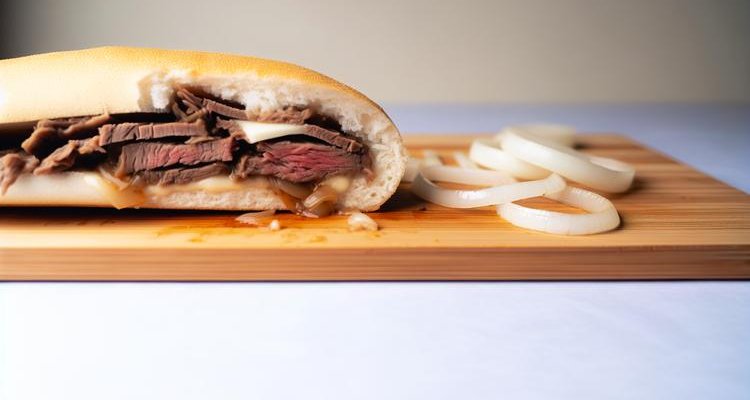
Frequently Asked Questions
What’s the best cheese for an authentic Philly cheesesteak?
All three traditional options—Cheez Whiz, provolone, and white American—are authentic. Cheez Whiz offers the classic creamy texture and is the choice at legendary spots like Geno’s and Pat’s. Provolone provides a sharper, more refined flavor. White American delivers mild creaminess without processed taste. Choose based on personal preference; there’s no single “correct” answer in Philadelphia.
Can I make Philly cheesesteaks without a flat-top griddle?
Yes, though results won’t match the real thing. Use the largest cast-iron skillet you own, preheated to high heat. Work in smaller batches to maintain temperature, and accept that you’ll have less workspace for managing onions and meat simultaneously. A griddle’s even heat distribution and large surface area are advantages, not requirements. The technique matters more than the specific equipment.
Should I really freeze the ribeye before slicing?
Absolutely. Room-temperature ribeye is nearly impossible to slice paper-thin by hand. Freezing for 30-60 minutes firms the meat just enough for clean, thin cuts while preventing the mushiness that occurs when slicing warm beef. Professional shops use commercial slicers, but freezing is the home cook’s equivalent technique. Don’t skip this step.
What griddle temperature is best for cooking Philly cheesesteaks?
Maintain 400-425°F for the meat cooking zone. This high heat creates the essential sear that develops flavor through the Maillard reaction while cooking paper-thin beef in just 2-3 minutes. Use a slightly cooler zone (around 350°F) for caramelizing onions. Temperature control is where griddles excel—use an infrared thermometer to verify surface temperature before adding ingredients.
How do I prevent the meat from overcooking and becoming dry?
The key is high heat and short cooking time. Paper-thin slices need only 2-3 minutes total. Let the initial sear develop for 30-45 seconds, then chop and toss quickly with spatulas. Add cheese during the final 30 seconds and remove immediately after melting. Ribeye’s natural marbling provides insurance against drying, but prolonged cooking at any temperature will toughen the meat. Speed is essential.
Why This Method Works
The flat-top griddle replicates Philadelphia street vendor conditions better than any other home cooking method. The even, high heat across a large surface, the ability to manage multiple ingredients simultaneously, and the quick searing action all contribute to authentic results. While you could approximate a cheesesteak in a skillet, you can’t truly replicate the technique without proper equipment.
More importantly, mastering these techniques opens doors to countless other flat-top applications. The temperature control, the two-spatula chopping method, the steam dome cheese-melting technique—all of these skills transfer to other griddle recipes. Whether you’re making smash burgers, fried rice, or breakfast hash, the fundamentals remain the same.
The beauty of Philly cheesesteaks lies in their simplicity. Four core ingredients—ribeye, onions, cheese, and bread—combine through proper technique into something far greater than the sum of parts. Master your griddle temperature, slice your beef paper-thin, caramelize those onions properly, and you’ll produce cheesesteaks that rival anything you’d find on the streets of Philadelphia.
Flat-Top Philly Cheesesteak Recipe (Authentic Griddle Method)
Equipment
- Flat-top griddle outdoor or indoor model
- Infrared thermometer recommended for temperature accuracy
- 2 metal spatulas wide, professional-grade
- Metal bowl or steam dome for melting cheese
- Sharp slicing knife
- Cutting board
Ingredients
- 2 pounds ribeye steak frozen 30-60 minutes, sliced paper-thin
- 2 large yellow onions sliced into thin half-moons
- 8 slices white American cheese OR 8 slices provolone OR 1/2 cup Cheez Whiz
- 4 fresh Italian hoagie rolls 6-8 inches each
- 2 tablespoons neutral oil vegetable or canola
- 1 teaspoon kosher salt
- 1/2 teaspoon black pepper
- hot peppers or sweet peppers optional, for serving
Instructions
- Preheat flat-top griddle to 350°F in one zone for onions. Add 1 tablespoon oil to griddle surface. Spread sliced onions in thin layer and season with 1/2 teaspoon salt. Cook for 10 minutes, stirring occasionally, until golden and caramelized. Move to cooler edge of griddle.
- Increase heat in main cooking zone to 400-425°F. Verify temperature with infrared thermometer or water droplet test (should evaporate in 2-3 seconds).
- Add remaining 1 tablespoon oil to hot zone. Spread paper-thin ribeye slices in even layer across griddle. Season with remaining salt and black pepper. Let sear undisturbed for 45 seconds.
- Using two metal spatulas, chop and toss meat with quick motions, breaking up any clumps. Continue cooking and chopping for 2 minutes until meat is browned and cooked through.
- Combine caramelized onions with cooked meat, mixing thoroughly. Divide mixture into 4 equal portions on griddle.
- Top each portion with 2 slices cheese (or 2 tablespoons Cheez Whiz). Immediately cover each portion with metal bowl or dome to trap steam. Let steam for 30 seconds until cheese is fully melted.
- While cheese melts, toast hoagie rolls cut-side down on cooler zone of griddle for 90 seconds until lightly golden.
- Remove domes. Using spatulas, scoop each meat-cheese-onion portion in one motion and transfer to toasted hoagie roll. Serve immediately with optional peppers.
Notes
Contents
- The Flat-Top Advantage: Why This Method Matters
- Choosing Your Ribeye: The Foundation of Flavor
- Mastering Griddle Temperature and Timing
- The Great Cheese Debate: Whiz, Provolone, or American?
- Assembly Technique: Building the Perfect Sandwich
- Common Mistakes and How to Avoid Them
- Serving and Variations
- Frequently Asked Questions
- Why This Method Works
- Flat-Top Philly Cheesesteak Recipe (Authentic Griddle Method)

